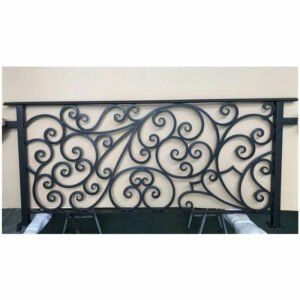The weight of a wrought iron fence can have significant implications for both the installation process and the overall functionality of the fence.
Here are ways in which the weight of wrought iron fences impacts installation and functionality:
- Installation Challenges:
- Heavy Lifting: Wrought iron fences are often substantial in weight, which can make the installation process more labor-intensive. Heavy sections of the fence may require specialized equipment or additional manpower for lifting and positioning.
- Foundation and Support Requirements:
- Structural Support: The weight of the fence influences the structural support needed for proper installation. The posts and foundation must be designed to bear the weight of the entire fence without sinking or shifting over time.
- Installation Time and Cost:
- Extended Installation Time: The heavier the wrought iron fence, the longer the installation process may take. This can impact the overall timeline of a construction or landscaping project.
- Increased Installation Costs: The labor and equipment required for handling heavy materials may contribute to higher installation costs. wrought iron fence manufacturer Contractors may need to allocate more resources for a heavier fence.
- Soil Conditions:
- Soil Load Bearing Capacity: The weight of the fence and the type of soil on the installation site are interconnected. In areas with weak soil, additional measures may be necessary to provide stable support for the heavy fence.
- Transportation and Handling:
- Transportation Challenges: Transporting heavy wrought iron fence sections to the installation site can present logistical challenges. Specialized vehicles and equipment may be required for safe transportation.
- Handling Difficulties: Workers need to exercise caution when handling heavy fence sections to prevent injuries. Adequate safety measures should be in place during the transportation and installation process.
- Footings and Concrete Requirements:
- Deeper Footings: The weight of the fence may necessitate deeper footings to provide adequate stability. Deeper footings distribute the weight more effectively, preventing issues like leaning or shifting.
- Concrete Usage: Heavier fences often require more concrete for the footings, increasing material costs. Properly proportioned and reinforced concrete footings are essential for stability.
- Gate Operation:
- Gate Functionality: The weight of gate sections is crucial for determining the ease of operation. Heavy gates may require sturdy hinges, reliable latching mechanisms, and possibly motorized opening systems for smooth functionality.
- Wind Load Resistance:
- Wind Load Considerations: Heavier wrought iron fences may have increased wind resistance, which can be advantageous in areas prone to strong winds. However, the design and installation must account for wind load to prevent damage or instability.
- Maintenance and Repairs:
- Structural Integrity: The weight of the fence affects its overall structural integrity. Periodic inspections are necessary to identify any signs of stress, wear, or damage that may compromise the functionality and safety of the fence.
- Repair Challenges: Repairs to a heavy wrought iron fence can be more challenging and may require specialized skills and equipment.
- Local Building Codes:
- Compliance Requirements: Local building codes may have specific requirements regarding the weight and installation of fences. Compliance with these regulations is essential to ensure the safety and legality of the installation.
In summary, the weight of wrought iron fences impacts various aspects of the installation process, structural considerations, and overall functionality. Proper planning, adherence to building codes, and consideration of site-specific conditions are crucial for ensuring a successful installation that meets both aesthetic and functional requirements.
